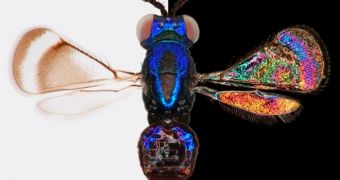It took centuries before someone finally noticed that the apparently dull, transparent wings of insects are filled with a multitude of colors, visible to the naked eye.
At some point we all admired the wings of a beetle or of a colorful butterfly, but when people see a simple fly, they never think of the color of its wings.
And still, the wing colors of many flies and wasps are not random iridescence, as scientists believed before, and “given favorable light conditions, they display a world of brightly patterned wings that are apparently unnoticed by contemporary biologists.”
This is what researchers led by University of Lund entomologists Ekaterina Shevtsova and Christer Hansson, wrote in a paper appearing a month ago in Proceedings of the National Academy of Sciences, paper that not many have noticed (just like for the colors of insect wings).
Study co-author Daniel Janzen, an evolutionary ecologist at the University of Pennsylvania, said that “you hold the wing up against the light, so you can see the veins,” and “if you’re looking through a microscope, you try to get a clear view behind the wing.
“It’s the antithesis of getting wing color.”
The one thing this team of researchers did differently, was to study wings under microscopes, against black backgrounds.
And once Janzen – who breeds wasps for his research on caterpillar-parasite symbioses, started to look at the wings this way, he could see the colors with the naked eye as wings passed over insects’ black bodies.
He was so excited that he said that “they flash like little diamonds.”
The wings of wasps and flies are made of two compressed layers of transparent chitin, so when light bounces off both layers the rays mix and produce color.
It's the same principle as for soap bubbles and oil slicks, so this is why scientists considered transparent wing coloration “a soap bubble iridescence effect, with randomly changing colors flashing over the wing surface,” the researchers said.
It's just that after this last analysis, the researchers found that surface variations in chitin filtered out the iridescence, and the remaining colors proved to be stable and visible from almost any angle.
Also, the wings colors were consistently different between species and sex, Wired Science reports.
So how come so many generations of biologists missed this?
The researchers from Lund say that there are two explanations: first of all, nobody looked for this specifically, and second of all, the colors are most evident against a dark background, and most entomologists study transparent wings against a white background (which makes them invisible).
The coloration of the wings is believed to have specific functions, especially for mating, just like in butterflies and beetles, as well as other colorful insects.
The wings patterns will also help scientists make the difference between species difficult to tell apart in other ways (they have already identified three new species of wasp).
Janen said that at least a dozen other orders of insects, including dragonflies, cockroaches and grasshoppers, have transparent wings that could be as colorful as those of wasps and flies.
“I envision taxonomists going back to their animals, and looking at them in a new light,” he said.
“It’s like discovering a whole new piece of the animal.”

 14 DAY TRIAL //
14 DAY TRIAL //